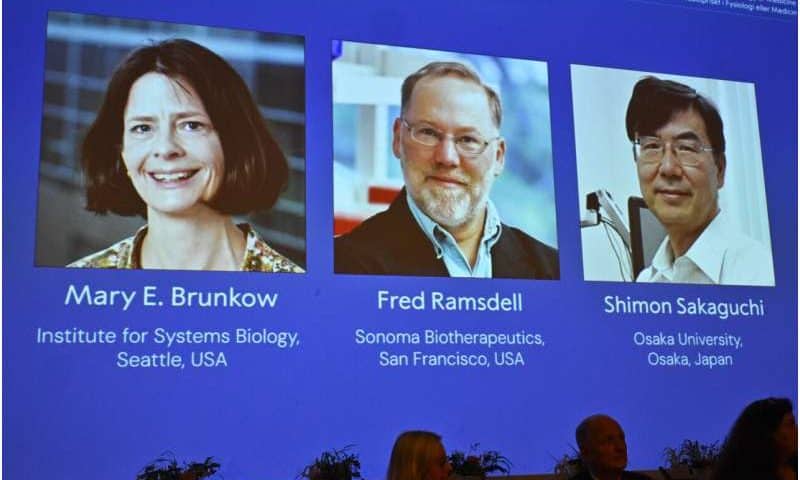Mary E. Brunkow, Fred Ramsdell and Dr. Shimon Sakaguchi won the Nobel Prize in medicine on Monday for their discoveries concerning peripheral immune tolerance.
Brunkow, 64, is a senior program manager at the Institute for Systems Biology in Seattle. Ramsdell, 64, is a scientific adviser for Sonoma Biotherapeutics in San Francisco. Sakaguchi, 74, is a distinguished professor at the Immunology Frontier Research Center at Osaka University in Japan.
The immune system has many overlapping systems to detect and fight bacteria, viruses and other bad actors. Key immune warriors such as T cells get trained on how to spot bad actors. If some instead go awry in a way that might trigger autoimmune diseases, they’re supposed to be eliminated in the thymus—a process called central tolerance.
The Nobel winners unraveled an additional way the body keeps the system in check.
The Nobel Committee said it started with Sakaguchi’s discovery in 1995 of a previously unknown T cell subtype now known as regulatory T cells or T-regs.
Then in 2001, Brunkow and Ramsdell discovered a culprit mutation in a gene named Foxp3, a gene that also plays a role in a rare human autoimmune disease.
The Nobel Committee said two years later, Sakaguchi linked the discoveries to show that the Foxp3 gene controls the development of those T-regs—which in turn act as a security guard to find and curb other forms of T cells that overreact.
The work opened a new field of immunology, said Karolinska Institute rheumatology professor Marie Wahren-Herlenius. Researchers around the world now are working to use regulatory T cells to develop treatments for autoimmune diseases and cancer.
“Their discoveries have been decisive for our understanding of how the immune system functions and why we do not all develop serious autoimmune diseases,” said Olle Kämpe, chair of the Nobel Committee.
Thomas Perlmann, Secretary-General of the Nobel Committee, said he was only able to reach Sakaguchi by phone Monday morning.
“I got hold of him at his lab and he sounded incredibly grateful, expressed that it was a fantastic honor. He was quite taken by the news,” Perlmann said. He added that he left voicemails for Brunkow and Ramsdell.
The award is the first of the 2025 Nobel Prize announcements and was announced by a panel at the Karolinska Institute in Stockholm.
Nobel announcements continue with the physics prize on Tuesday, chemistry on Wednesday and literature on Thursday. The Nobel Peace Prize will be announced Friday and the Nobel Memorial Prize in economics Oct. 13.
The award ceremony will be held Dec. 10, the anniversary of the death of Alfred Nobel, who founded the prizes. Nobel was a wealthy Swedish industrialist and the inventor of dynamite. He died in 1896.
The trio will share the prize money of 11 million Swedish kronor (nearly $1.2 million).
Nobel committee announcement:
The Nobel Assembly at Karolinska Institutet has decided to award the 2025 Nobel Prize in Physiology or Medicine to:
Mary E. Brunkow, Institute for Systems Biology, Seattle, U.S.
Fred Ramsdell, Sonoma Biotherapeutics,San Francisco, U.S.
Shimon Sakaguchi, Osaka University, Osaka, Japan
“for their discoveries concerning peripheral immune tolerance”
They discovered how the immune system is kept in check
The body’s powerful immune system must be regulated, or it may attack our own organs. Mary E. Brunkow, Fred Ramsdell and Shimon Sakaguchi are awarded the Nobel Prize in Physiology or Medicine 2025 for their groundbreaking discoveries concerning peripheral immune tolerance that prevents the immune system from harming the body.
Every day, our immune system protects us from thousands of different microbes trying to invade our bodies. These all have different appearances, and many have developed similarities with human cells as a form of camouflage. So how does the immune system determine what it should attack and what it should defend?
Mary Brunkow, Fred Ramsdell and Shimon Sakaguchi are awarded the Nobel Prize in Physiology or Medicine 2025 for their fundamental discoveries relating to peripheral immune tolerance. The laureates identified the immune system’s security guards, regulatory T cells, which prevent immune cells from attacking our own body.
“Their discoveries have been decisive for our understanding of how the immune system functions and why we do not all develop serious autoimmune diseases,” says Olle Kämpe, chair of the Nobel Committee.
Shimon Sakaguchi was swimming against the tide in 1995, when he made the first key discovery. At the time, many researchers were convinced that immune tolerance only developed due to potentially harmful immune cells being eliminated in the thymus, through a process called central tolerance. Sakaguchi showed that the immune system is more complex and discovered a previously unknown class of immune cells, which protect the body from autoimmune diseases.
Mary Brunkow and Fred Ramsdell made the other key discovery in 2001, when they presented the explanation for why a specific mouse strain was particularly vulnerable to autoimmune diseases. They had discovered that the mice have a mutation in a gene that they named Foxp3. They also showed that mutations in the human equivalent of this gene cause a serious autoimmune disease, IPEX.
Two years after this, Shimon Sakaguchi was able to link these discoveries. He proved that the Foxp3 gene governs the development of the cells he identified in 1995. These cells, now known as regulatory T cells, monitor other immune cells and ensure that our immune system tolerates our own tissues.
The laureates’ discoveries launched the field of peripheral tolerance, spurring the development of medical treatments for cancer and autoimmune diseases. This may also lead to more successful transplantations. Several of these treatments are now undergoing clinical trials.

